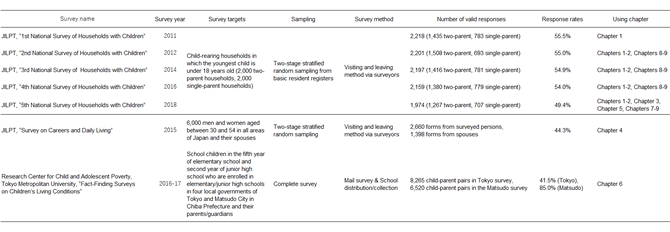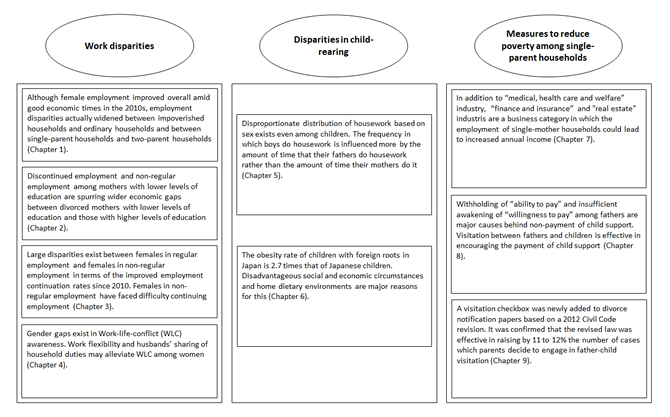JILPT Research Report No.208
Disparities Associated with Work and Child-Rearing
March 22, 2021
Summary
Research Objective
Good economic times in Japan during the 2010s lead to an increase of as much as 2.07 million in the number of employed Japanese females (aged between 15 and 64) during the seven years between the end of 2012 and the end of 2019. At the same time, the female employment rate reached an all-time high. In 2018, the employment rate for females between the ages of 15 and 64 reached 69.6%, and it surpassed those of the United States (65.5) and France (62.0%) beginning more than five years before. For a six-year period that began in 2012, when Japan’s economy began to recover, the female employment rate rose by nine percentage points, a pace that is high even by international standards.
While there are positive trends in female employment, there is also a lurking danger of widening disparities between the “haves” and “have-nots” within the female group. For example, there is a trend of “assortative mating,” whereby, in general, women with higher levels of education marry men with high income, and women with lower levels of education marry men with low income (Raymo and Iwasawa 2005, JILPT 2017)[Note 1]. Additionally, there is a considerable risk that women with lower levels of education are more prone to divorce and more likely to fall into economic hardship. Well-educated women in households in medium- to high-income groups who have solid information-gathering skills and possess more human capital are highly likely to continue their careers even after childbirth by actively using national employment support schemes or to find reemployment with excellent conditions in a good labor market. On the other hand, women of impoverished households who have lower levels of education and lack means for accessing information are often excluded from the benefits of enhanced support schemes and good economic times. As a result, employment disparities among women may actually increase even though good economic times prevail and expanded employment support schemes become available.
Improvements in female employment that are skewed toward medium- and high-income groups are likely to spur the polarization of household income. Additionally, it has been pointed out that economic hardship in the home can induce problems of children including poor academic performance, obesity and other health problems, and emotional problems such as decreased self-esteem and self-efficacy. Consequently, growing employment disparities among women could end up widening disparities among children. In other words, we can surmise that growing disparities among women will accelerate the polarization of household incomes, and eventually develop into a problem for children.
Taking into account today’s social background described above, this report explores the realities and background of growing disparities in terms of work and child-rearing of Japanese women since the 2010s based on the results of JILPT household surveys. It also considers specific ways of reducing poverty in single-parent households, whose economic hardship tends to be particularly severe.
Note 1. Raymo, J. and M. Iwasawa. (2005) “Marriage Market Mismatches in Japan: An Alternative View of the Relationship between Women’s Education and Marriage.” American Sociological Review 70: 801–822. JILPT (2017) Survey on Living Standards of Households with Children and the Employment Status of Their Parents 2016: 4th National Survey of Households with Children (2017). JILPT Research Series No.175.
Research Method
Analysis of micro data from the following questionnaire surveys.
Table 1. Main Surveys Used in the Report’s Analysis

Click to enlarge
Notes: 1. See JILPT (2012, 2013, 2015, 2017a, 2017b, and 2019) for details on survey methods and results.
2. For details on the “Fact-Finding Surveys on Children’s Living Conditions,” see the web page of the Bureau of Social Welfare and Public Health, Tokyo Metropolitan Government, titled “‘Kodomo no Seikatsu Jittai Chosa’ no Kekka ni tsuite” (regarding the results of the fact-finding surveys on children’s living condition) and the web page of Matsudo City titled “Matsudo-shi Kosodate Setai Seikatsu Jittai Chosa Jisshi Kekka” (results of the Matsudo City fact-finding survey of the living conditions of child-rearing households). (From page 3 of the report)
Key Findings
This report explores the realities and background of growing disparities in work and child-rearing that lurk behind the good economic times of the 2010s and improved overall female employment. Most of its exploration is based on the results of an empirical analysis of individual data from large-scale national surveys that were conducted at multiple time points (mainly the “National Survey of Households with Children”).
The results of the analysis point to growing disparities in terms of the work of child-rearing women. Chapter 1 (Abe) reveals that, although female employment improved overall amid good economic times in the 2010s, employment disparities actually widened between impoverished households and ordinary households and between single-parent households and two-parent households. Chapter 2 (Raymo and Wang) relates discontinued employment and non-regular employment among mothers with lower levels of education to widening economic gaps between divorced mothers with lower levels of education and those with higher levels of education. Chapter 3 (Nakazato) clarifies that the improved employment continuation rates since 2010 are skewed toward females in regular employment and that females in non-regular employment have faced difficulty continuing employment. And Chapter 4 (Mitarai) points out the existence of gender gaps in awareness of work-life conflict (WLC) and suggests that work flexibility and husbands’ sharing of household duties may alleviate WLC among women.
Although the analysis is limited to a specific theme, disparities in terms of child-rearing are also observed in its results. Chapter 5 (Nishimura) confirms that the disproportionate distribution of housework based on sex exists even among children, and it demonstrates that the frequency in which boys do housework is influenced more by the amount of time that their fathers devote to housework rather than the amount of time their mothers do it. And Chapter 6 (Zhou) presents the shocking finding that the obesity rate of children with foreign roots in Japan, whose number is increasing rapidly, is 2.7 times that of Japanese children, and it identifies disadvantageous social and economic circumstances and home dietary environments as major reasons for this.
The report also discusses measures to reduce poverty among single-mother households with attention to the business categories and characteristics of work, securing child-support payments, and promoting visitation. Chapter 7 (Ikeda) suggests that “finance and insurance” and “real estate” industries are, in addition to “medical, health care and welfare” industry, business categories in which the employment of single-mother households should lead to increased annual income. Chapter 8 (Zhou) identifies the withholding of “ability to pay” and insufficient awakening of “willingness to pay” among fathers to be major causes behind non-payment of child support, and it demonstrates that visitation between fathers and children encourages the payment of child support. And Chapter 9 (Oishi) confirms that a 2012 Civil Code revision was effective in raising by 11 to 12% the number of cases in which parents decide to engage in father-child visitation.
Figure 1. Main Themes and Findings of Each Chapter

Click to enlarge
Source: Arranged by the author.
Policy Implications
Three main policy implications can be gleaned from the above analysis. The first is the importance of providing effective support so that even women of impoverished households with lower levels of education can benefit from the employment support system enhancements in a timely manner. What is needed is the development of “companion-type” one-stop support service that uses various tools to reliably deliver information on available assistance to vulnerable people who cannot call for help on their own.
Next, support programs in schools and society must be enhanced to minimize the disadvantages that economic hardship in the home and unhealthy nurturing environments have on children. It may be beneficial here to consider support in such areas as providing free breakfasts to children who routinely go without breakfast, providing free study support during after-school hours, and strengthening career education and counseling services.
Finally, for single-parent households that bear particularly heavy economic hardship, consideration should be given to expanding the range of occupations eligible for public vocational training, to initiatives designed to awaken parents’ “willingness to pay” child support, and to the compulsory collection of child-support payments.
Policy Contribution
The outcomes of this study are expected to be used as background data in designing policies related to women’s empowerment and child-rearing support.
Contents
- JILPT Research Report No.208, full text (PDF:3.0MB) [in Japanese]
Research Categories
Project research: Research on Worker and Corporate Behavior Strategies amid “Work Style Reform”
Sub-theme: Research on Employment and Safety Nets during Child Care and Family Care
Research Period
April 2017 - March 2020
Authors (in order of writings)
- Yanfei Zhou
- Professor, Faculty of Integrated Arts and Social Sciences, Japan Women’s University (JILPT Senior Researcher, at the time of writing)
- Aya Abe
- Professor, Faculty of Humanities and Social Sciences, Tokyo Metropolitan University
- James Raymo
- Professor, Department of Sociology, Princeton University
- Jia Wang
- Doctoral Student, University of Wisconsin-Madison
- Hideki Nakazato
- Professor, Department of Sociology, Konan University
- Yuka Mitarai
- JILPT Assistant Fellow (at the time of writing)
- Junko Nishimura
- Associate Professor, Faculty of Core Research, Human Science Division, Ochanomizu University
- Shingou Ikeda
- JILPT Senior Researcher
- Akiko Oishi
- Professor, Graduate School of Social Sciences, Chiba University
Category
Workers' life / Workers' awareness
Related Research Results
- JILPT Research Series No.95, Survey on Living Standards of Households with Children and the Employment Status of Their Parents (2012).
- JILPT Research Series No.109, Survey on Living Standards of Households with Children and the Employment Status of Their Parents 2012: 2nd National Survey of Households with Children (2013).
- JILPT Research Series No.145, Survey on Living Standards of Households with Children and the Employment Status of Their Parents 2014: 3rd National Survey of Households with Children (2015).
- JILPT Research Series No.169, Men’s and Women’s Careers and Corporate Human Resource Management (2017).
- JILPT Research Series No.175, Survey on Living Standards of Households with Children and the Employment Status of Their Parents 2016: 4th National Survey of Households with Children (2017).
- JILPT Research Series No.192, Survey on Living Standards of Households with Children and the Employment Status of Their Parents 2018: 5th National Survey of Households with Children (2019).
JILPT Research Report at a Glance
| To view PDF files, you will need Adobe Acrobat Reader Software installed on your computer.The Adobe Acrobat Reader can be downloaded from this banner. |

